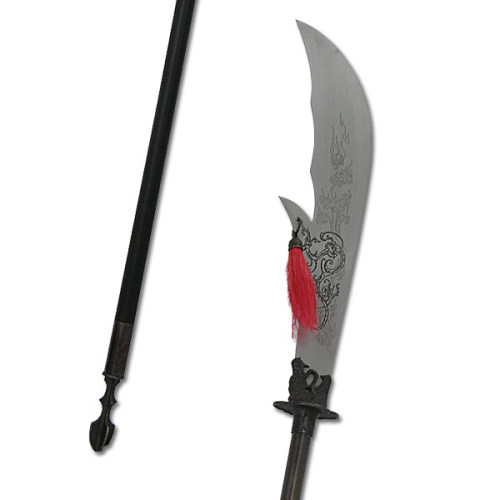 Glaive — a type of a drevkovy infantry cold weapon of near fight. Consists of a staff (1,2 — 1,5 meters) and a tip (40 — 60 centimeters, width of 5-7 centimeters). The staff usually becomes covered by rivets or courts a metal tape for protection from a pererubaniye. The tip — a blade, looks like ground only on the one hand wide falchion. The thorn parallel or directed at a small angle to a blade departs from a butt of a tip (so-called "a sharp finger"), the employee, first, for weapon capture at blow reflection from above, and secondly, for drawing more effective against the opponents of pricking blows chained in armor (unlike blows cutting, put with a tip). However the main destination Glaive — nevertheless drawing cutting blows. On the lower part of a staff also there was a tip (so-called. "heel"), but it usually wasn't sharpened, and simply pointed — it was used as a counterbalance for balancing of the weapon and for a dobivaniye of wounded.
Glaive — a type of a drevkovy infantry cold weapon of near fight. Consists of a staff (1,2 — 1,5 meters) and a tip (40 — 60 centimeters, width of 5-7 centimeters). The staff usually becomes covered by rivets or courts a metal tape for protection from a pererubaniye. The tip — a blade, looks like ground only on the one hand wide falchion. The thorn parallel or directed at a small angle to a blade departs from a butt of a tip (so-called "a sharp finger"), the employee, first, for weapon capture at blow reflection from above, and secondly, for drawing more effective against the opponents of pricking blows chained in armor (unlike blows cutting, put with a tip). However the main destination Glaive — nevertheless drawing cutting blows. On the lower part of a staff also there was a tip (so-called. "heel"), but it usually wasn't sharpened, and simply pointed — it was used as a counterbalance for balancing of the weapon and for a dobivaniye of wounded.The name Glaive comes from French. Practically all researchers carry out etymology of this word to armor. gladius or to the Celtic cladivos, designating "sword". However, all early English and French links on Glaive mean a spear. In this value the word Glaive appears in English approximately with XIV to the middle of the XVI centuries. The present value Glaive gets the word since the XV century. Approximately in the same time the word Glaive becomes poetic designation of a sword (in this value it is most often used Glaive in modern French).
There were various modifications Glaive — beginning from identical two-edged narrow long blades on both ends of a staff and to a wide tip reminding an axe on one end and a simple spherical counterbalance on other. Dvukhlezviyny modification meets extremely seldom and is the weapon of the single as to fight it is possible for it only on rotation, and in close fight the fighter with such glefy will destroy all around, including own colleagues. In total modifications Glaive about 100.
Glaive it was used as an individual weapon since the 14th century, in particular — as personal arms of arbaletchik in Burgundy. Well I proved to be as the weapon for reflection of attacks of a cavalry. Till the 18th century it was used as the weapon of palace guards, then I went out of use. Now glyphs armed only the Swiss guard protecting Vatican.
Комментариев нет:
Отправить комментарий